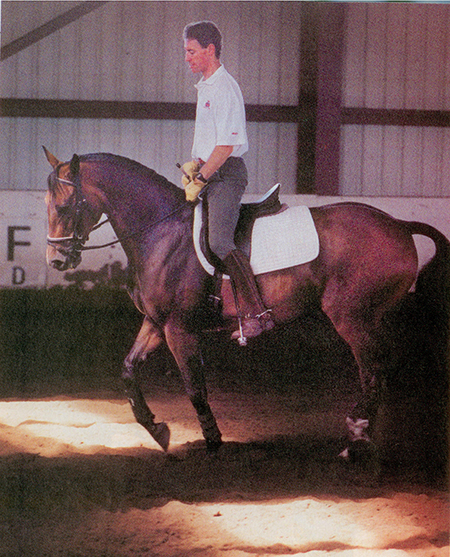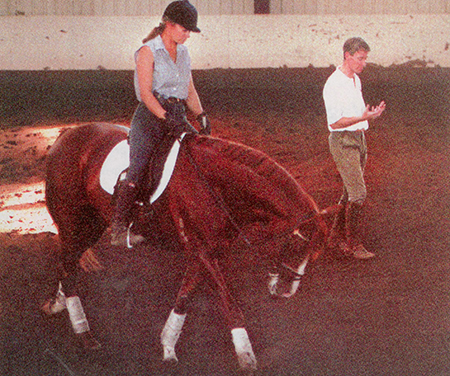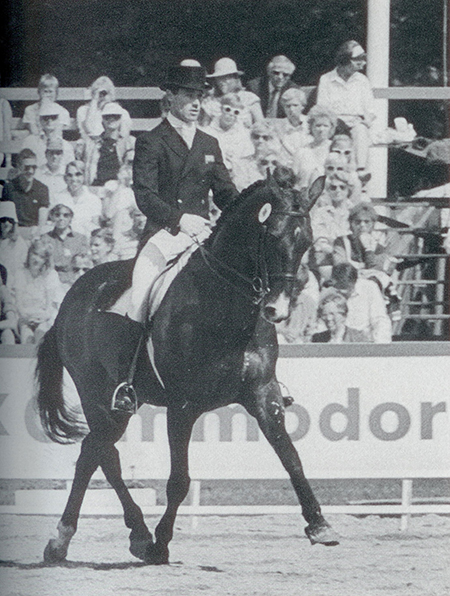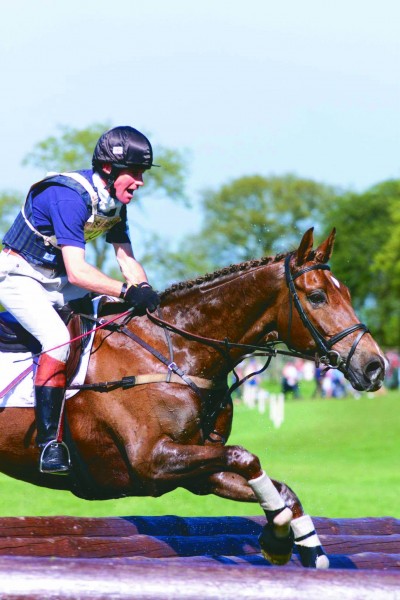
“You’ve heard me say to riders ‘don’t give the rein away, and say look, my horse is light, and then take it back’, because in doing that you have changed the contact and you’ve sent them a signal to the mouth that you wanted them to ignore.”
“That’s something we’ve got to be careful about, making sure that the signals we send are the ones that we mean and not the ones that we don’t mean, until the horse gradually gets the understanding.”
“And one more thing, I talk to the riders, I say to them that the bit and the action that you send down the rein to the bit to the horse’s mouth is the equivalent of sending a signal to the horse’s side with a touch of the spur or a sting of the whip, it is something that is saying to them ‘listen’ it’s saying ‘listen to my posture, listen to my balance, listen to what I’m saying’.”
“You have to get the horse to blink, to pay attention, particularly the horse that is in the habit of just ignoring totally everything that is said down the rein. You’ve got to make them blink, so sometimes I really rattle the bit to shock them out of what they’re doing. The objective is to get them to the point where a little tremor on the rein says ‘listen’, and ideally I can get to the point in my dream where I can ride and say ‘look no hands’ and my horse will do anything. I say it’s a dream because I’ve never got there yet, but it’s something you could possibly imagine being attainable in the long run … if you stayed alive long enough!”
Position established, basic guidelines for walk and trot set out, and it’s time for the hard stuff.
“See how close you can get to walk without losing the rhythm of the trot,” he tells pupil after pupil as he encourages them towards the zone.
(If you missed last month’s article, don’t panic, it’s not a new Stephen King film, it’s Christopher’s pet name for that limbo land between trot and walk!).
“Don’t hold as you rise into the next step, you must soften your hand into the rise.”
He reminds the rider to walk on a rise step, and make a turn about the forehand before beginning with a snappy trot step in the new direction.
“On the turn, it is more a turn about the forehand than a turn on the forehand,” he emphasises.
“I call it a turn about an imaginary post. I have fat posts and thin posts, around which I am doing a turn about the forehand.”
“So the horse has got to keep stepping forward as he crosses the inside hind under his body. What I’m asking the horse to do is put his inside hindleg under the body between the footprints of the two front feet. I don’t want the horse stepping outwards with the outside hind as the first step. I want the inside hind stepping under as the first step and the outside hind stepping forward as the second step.”
“In that way your horse keeps walking forward around the post. If you find that your horse doesn’t keep walking around the post as he does this, stepping over with his inside hind, it is because you are allowing the outside hind to escape outwards.”
“The constant change in direction is to keep my horse alive and think ‘what leg am I touching you with?’. So I walk, turn about the forehand outwards on the circle, and in so doing I am engaging the new inside hindleg, before going off onto the next circle. When I don’t actually make that transition I am going through my figure of eight.”
“As I make the circle smaller, my trot circle comes down from 20m, to 15m, to 10m, to 8m, to 6m and I start doing a 6m figure of eight and I’ve got to engage the new inside hindleg and that’s a little bit like riding that turn about the forehand outwards.”
“But there is a fine line because you only want to plot the inside hind under the body, after that you don’t want the horse drifting outwards, leg yielding outwards. You want the shoulder to come round, so it starts with the inside hind and it finishes with a bit more the outside leg bringing the forehand around as a pirouette.
“Quarters out, use your inside leg as you go into the turn, half halt on the outside rein to slow the horse. Turn about the forehand but keep the rhythm.”
“This is to encourage the inside leg to step under the horse. When turning, think outwards on the circle and they will come lighter on the outside rein more quickly. Think shoulder-in, if anything. Don’t push the quarters in. Turn him with your inside leg, half halting with the outside leg. I don’t want the horse’s inside hindleg to drag along through the dirt, I want him to pick it up, and put it down.”
“On the turn, I want no scuffing with that inside hindleg, I want a knee-jerk reaction. And hold your position.”
Christopher is of the belief that it doesn’t do any harm to keep the horse on its toes by continuing to turn him, until eventually the horse is at the point where the rider no longer has to come back from trot to walk to perform the turn about the forehand unless the rider actually chooses to.”
That’s when it moves into the 6m figure of eight circles.
“This is a little bit like the turn on the forehand, a little bit like a pirouette, The rider feeling which leg to touch with next, left leg into right leg, right leg into left leg,” he explains.
“The object is to loosen the horse and also to collect him. When he gets a bit strong in the trot, think of your rising trot rhythm, that’s why I say not to lean back too much. Think light in the saddle.”
“Ideally you should get to the point where you can do it with the reins in one hand, you let them do it for you.”
“In the trot I am going ‘check, check, check’ with the outside rein, ‘wait and soften’, just putting the pennies down the slot in the outside rein.”
Pennies in the slot is one of Christopher’s favourite analogies.
“The pennies in the slot is to get the timing of the half-halt right,” he says. “It’s also to see if the machine works. If you keep stuffing coins in a machine and don’t wait to see if it’s worked, you might find that it worked a long time ago and you might have lost a lot of money. That’s if you want to use that analogy.”
“But the main reason I talk about pennies in the slot is that when you use those slot machines you have to put one coin in, then you have to put another one in, and in between there’s a pause, and it gives the machine a chance to work, it gives your horse a chance to understand what you’re actually wanting and bit by bit, if you’re consistent, and if you’re prepared sometimes to turn the penny into a dollar, or into a pound, make the actions quicker, sharper and yet still timed to allow the horse to respond, then the horse will start to pay attention to those signals, won’t block them out.”
“I think riders frequently don’t sufficiently put themselves into the horse’s mind, they’re not sufficiently the horse themselves.”
“Imagine what it’s like to be ridden, imagine what it’s like with someone pulling on your mouth and kicking your sides, poking you with spurs, smacking you with whips, and imagine what your reaction would be if you hadn’t got a clue about what it was they were trying to do.”
“I would love to see a situation where you told somebody to get a stranger off the street and say to them ‘OK, I want you without any verbal commands, without any demonstration, with this whip, spurs, rope, anything you like, to teach that person to waltz, or do a dance, or do something, for the next half an hour’. And the total stranger who has just been asked to be a volunteer comes in and gets tied up and poked and prodded – they’d probably slug you before you got anywhere near it!”
“So we have to do like I say, put ourselves into the horse’s mind and understand what it’s like to get these signals. And the horses learn things, I think, by accident. They learn that by accident they did something that led to the pressure coming off. Suddenly life gets easier.”
Once you can accommodate Christopher’s system in the trot, incorporating the rising trot, rising trot-walk-rising trot and sitting trot-walk-sitting trot, and the transitions within the pace, keeping the rhythm and stepping higher and shorter without losing that rhythm (that’s all!), it is time to move on into the lateral work.
“As soon as I have a feeling that there’s an understanding of the basics of posture you just want to try to carry that on into the rest of your work,” Christopher explains.
And always, he adds, you must be chanting like a mantra in your head ‘rhy-thm, rhy-thm, rhy-thm’ in time with the horse’s diagonal steps.
“It should be clicking in your mind like a metronome through the lateral work,” he says.
“In the lateral work you are trying to think always of the rhythm, with the outside rein half-halting in time.”
“In the leg yielding, you must open the outside rein to allow the shoulder to come forward and across, the leg maintaining the horse’s position.”
You can begin with the basic leg yielding across the diagonal (and Christopher is of the school that comes around on the right rein and leg yields off the wall away from the left leg).
From there, you progress to shoulder-in down the long side, back into walk whilst staying in shoulder-in, a few steps of walk shoulder-in and into a walk pirouette and snapping back into trot and smartly picking up the ‘rhy-thm’ again.
Nothing changes in the shoulder-in, he emphasises. The rider must still be thinking ‘rhy-thm’ and there must still be little signals sent down the outside rein. There must be no change in the angle or the posture through the transition into walk and again, nothing is thrown away in the walk pirouette.
And so on to half pass …
“In half pass, you point the horse’s face where you are aiming, and think of travers,” he explains. “You can half pass to the wall, then leg yield away from the wall, come back into half pass with the inside hind coming forward, so that you can feel him pushing against your inside leg. If he is heavy on your outside rein, you go into leg yielding.”
“Don’t help him too much, he will lose it, but just keep thinking of the rhythm, don’t carry him, he must do it for himself.”
“If the horse is being too strong you can lighten the seat and when they stop pulling you can sit on them again.”
“Trust the horse, and if you do all of that and they are still being too strong, walk, and set off again.”
“You want lightness, you want self-carriage, but if you keep demanding shorter they will get to the poit where they won’t do it anymore.”
“You can try half pass to halt and lighten your seat a bit, loosen the thigh, let the fresh air pass through, rattle him off the bit when he is too strong, do it quickly to get a response.”
One visual aid that Christopher uses in his clinics is to tell the pupils to imagine a horse and rider combination that they most want to be like. It can be a combination only seen on video, or a horse and rider from your area that to you looks as you would like to look. Then, whilst you are riding, keep them firmly in mind’s eye.
As you are riding, keep comparing your horse and your feel to that video and keep the video running.
Just to make it more difficult, or effective, depending on how you look at it, Christopher suggests that you imagine that same video camera is held in your hands between the reins and that you are watching the small screen as you ride.
Christopher and Wily Trout…
Last month we learnt how Christopher Bartle drifted to the race track before he turned his attention to eventing… and there he was to meet a pretty special horse!
“From eventing I got into dressage when Wily Trout injured himself. I did my dressage stint through the 80s, finishing in 1987 when I retired Wily Trout and sold my other Grand Prix horse to Japan.”
“At the same time, coincidentally, I was offered a ride on an event horse that was very good cross-country but not too easy in the dressage. I got a tune out of him and he went quite well and had some good placings and one thing led to another and I was really back into the eventing, and I enjoyed that very much.”
Christopher is of the opinion that to win at top level, you have to have good horses and ‘you need a lot of luck’. Currently, he has two horses long listed for the Olympics and he’s hoping they’ll do well enough in final selection trials to be selected.
“With horses, each day is a potential disaster so I won’t get too excited about it, other than that I want to do my best and make sure that I don’t leave any stone unturned in trying to do the job,” he says.
“I’m realistic, I’m on the long list but I’m wouldn’t say I’m in the top 50%, I think I’m probably in the bottom 50%, but out of those 12, seven will go.”
Word Perfect at Badminton…
“Word Perfect II, who won Badminton, had a year off with injuries so there are two things about him, one, he has to prove he’s as good as he was, and second, he has to prove that he’s sound.”
“The other horse is called Oscar, he’s a horse I’ve had for four years, and he’s had a couple of placings in three-star events. He won the three-star in Germany at the end of last season, at Achselschwang and will do Badminton in the spring.”
“I would say the selectors would be less interested in him than the other horse but it’s results that count. People get over-excited about squads and whether they’re on the squad or not but at the end of the day what counts is results. It’s current form, not history.
“I haven’t got a dressage horse that’s good enough at the moment at FEI.”
“Do I miss dressage? Yes and no. If the right horse came along I would do it again, no doubt about it, but when you’ve been lucky, as I have been, to have one, really two horses that were good enough to be placing, 6th in the Olympics, 4th in the Europeans, all that sort of stuff, it’s difficult to find one that is going to go a lot better.”
“The thing about eventing is that you can have a lot of fun on a horse that is moderate, the parties are good, the buzz is there, you might even win an event on a moderate horse, but in the dressage game it’s not the same.
You’ve got to wait for the right one to come along. I’m not in the position of being able to go to Germany with a blank cheque to buy one so I just have to wait for something to come along that maybe has too many guns for somebody else, or is too difficult.”
“Dressage and eventing have a different buzz, really. In the eventing game there’s the terror followed by the exhilaration, as well as a certain degree of satisfaction if you’ve done a job well.”
“The dressage is all about having done a job well and being pleased with the way you’ve ridden and your horse has gone. I don’t really get a buzz from training it, I get a buzz out of winning… though having said that, there are times in the dressage when we’ve all been in the same position where sometimes your horse has gone really well and you’ve not been placed or not got a ribbon, and other times you’ve not been very happy with your horse and you’ve won.”



